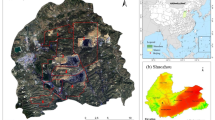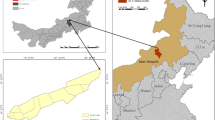Abstract
The dynamic change in the carbon sink value of the Heidaigou opencast mining area in the Inner Mongolia Autonomous Region of China was analyzed by remote sensing and geographical information system to investigate the effect of land rehabilitation and ecological reconstruction in mining area on the biogeochemical cycle of carbon. The mining area’s carbon sink volume and value from 1987 to 2010 were calculated according to carbon sink capacity differences across various vegetation and land use types. The results indicate the following conclusions. (1) The carbon sink volume and value decreased by 17 % over 23 years, from 7,217,104.59 t and $1,082.57 million to 5,990,016.2 t and $898.50 million, respectively. (2) Assuming a dump is rehabilitated with 20 % woodland and 80 % grassland, the carbon sink volume and value can increase to 6,593,952.5 t and $989.09 million, respectively. The value would increase by 10.08 % after land rehabilitation. (3) Assuming that other industrial land is rehabilitated with grassland after the dumps are completely rehabilitated, the carbon sink volume and value would increase to 6,742,684.36 t and $1011.40 million, respectively. The value would increase by 12.57 % after land rehabilitation. The results indicate that land rehabilitation and ecological reconstruction can increase mining area carbon sinks and produce ecological and economic benefits. This study provides a new perspective on land rehabilitation and ecological reconstruction.




Similar content being viewed by others
References
Adams DM, Alig RJ, McCarl BA, Callaway JM, Winnett SM (1999) Minimum cost strategies for sequestering carbon in forests. Land Econ 75(3):360–374. doi:10.2307/3147183
Amichev BY, Burger JA, Rodrigue JA (2008) Carbon sequestration by forests and soils on mined land in the Midwestern and Appalachian coalfields of the US. For Ecol Manage 256(11):1949–1959. doi:10.1016/j.foreco.2008.07.020
Beardsley TM (2010) Biological carbon sequestration. Bioscience 60(9):671. doi:10.1525/bio.2010.60.9.1
Brown S, Lugo AE (1982) The storage and production of organic matter in tropical forests and their role in the global carbon cycle. Biotropica 14(3):161–187. doi:10.2307/2388024
Caldwell IM, Maelaren VW, Chen JM, Ju WM, Zhou S, Yin Y, Boland A (2007) An integrated assessment model of carbon sequestration benefits: a case study of Liping country. J Environ Manag 85(3):757–773. doi:10.1016/j.jenvman.2006.08.020
Christopher SF, Lal R, Mishra U (2009) Regional study of no-till effects on carbon sequestration in Midwestern United States. Soil Sci Soc Am J 73(1):207–216. doi:10.2136/sssaj2007.0336
Dixon RK, Brown S, Houghton RA, Solomon AM, Trexler MC, Wisniewski J (1994) Carbon pools and flux of global forest ecosystems. Science 263(5144):185–190. doi:10.1126/science.263.5144.185
Field CB, Behrenfeld MJ, Randerson JT, Falkowski P (1998) Primary production of the biosphere: integrating terrestrial and oceanic components. Science 281(5374):237–240. doi:10.1126/science.281.5374.237
Jobbagy EG, Jackson RB (2000) The vertical distribution of soil organic carbon and its relation to climate and vegetation. Ecol Appl 10(2):423–436. doi:10.2307/2641104
Johnson WC, Sharpe DM (1983) The ratio of total to merchantable forest biomass and its application to the global carbon budget. Can J For Res 13(3):372–383
Lal R (2004) Soil carbon sequestration impacts on global climate change and food security. Science 304(5677):1623–1627. doi:10.1126/science.1097396
Li KR, Wang SQ, Cao MK (2003) Chinese vegetation and soil carbon storage. Chin Sci 33:72–80 (in Chinese)
Lieth H, Whittaker RH (1975) Primary productivity of the biosphere. Springer, New York
Lockwell J, Guidi W, Labrecque M (2012) Soil carbon sequestration potential of willows in short-rotation coppice established on abandoned farm lands. Plant Soil 360(1–2):299–318. doi:10.1007/s11104-012-1251-2
Luedeling E, Neufeldt H (2012) Carbon sequestration potential of parkland agroforestry in the Sahel. Clim Change 115(3–4):443–461. doi:10.1007/s10584-012-0438-0
Mahli Y, Nobre AD, Grace J, Kruijt B, Pereira MGP, Culf A, Scott S (1998) Carbon dioxide transfer over a central Amazonian rain forest. J Geophys Res 103(24):31593–31612. doi:10.1029/98JD02647
Mitchell SR, Harmon ME, O’Connell KEB (2012) Carbon debt and carbon sequestration parity in forest bioenergy production. GCB Bioenergy 4(6):818–827. doi:10.1111/j.1757-1707.2012.01173.x
Myneni RB, Dong J, Tucker CJ, Kaufmann RK, Kauppi PE, Liski J, Zhou L, Alexeyev V, Hughes MK (2001) A large carbon sink in the woody biomass of Northern forests. Proc Natl Acad Sci USA 98(26):14784–14789. doi:10.1073/pnas.261555198
Newell RG, Stavins RN (2000) Climate change and forest sinks: factors affecting the costs of carbon sequestration. J Environ Econ Manag 40(3):211–235. doi:10.1006/jeem.1999.1120
Perera MSA, Ranjith PG, Viete DR, Choi SK (2012) Parameters influencing the flow performance of natural cleat systems in deep coal seams experiencing carbon dioxide injection and sequestration. Int J Coal Geol 104:96–106. doi:10.1016/j.coal.2012.03.010
Phillips OL, Malhi Y, Higuchi N, Laurance WF, Nunez PV, Vasquez RM, Laurance SG, Ferreira LV, Stern M, Brown S, Grace J (1998) Changes in the carbon balance of tropical forests: evidence from long term plots. Science 282(5388):439–442. doi:10.1126/science.282.5388.439
Sharma DP, Singh M (2010) Assessing the carbon sequestration potential of subtropical pine forest in north-western Himalayas—a GIS approach. J Indian Soc Remote Sens 38(2):247–253. doi:10.1007/s12524-010-0031-9
Van Deusen P (2010) Carbon sequestration potential of forest land: management for products and bioenergy versus preservation. Biomass Bioenergy 34(12):1687–1694. doi:10.1016/j.biombioe.2010.03.007
Wang XK, Feng ZW (2000) The potential to sequester atmospheric carbon through forest ecosystems in China. Chin J Ecol 19(4):72–74 in Chinese
Wani SP, Chander G, Sahrawat KL, Rao CS, Raghvendra G, Susanna P, Pavani M (2012) Carbon sequestration and land rehabilitation through Jatropha curcas (L.) plantation in degraded lands. Agric Ecosyst Environ 161:112–120. doi:10.1016/j.agee.2012.07.028
Xu ZJ, Zhang SL, Hou HP (2011) Coal mining on mining land disturbance effect of carbon—the development of the transformation of the mode of mining land use of new areas of evaluation studies. Ind Econ 9:56–57 (in Chinese)
Zhang QY (2009) Evaluation of the major forest types of carbon sink function and the value of carbon sequestration in Yingjiang. J Shandong For Sci Technol 5:79–81 (in Chinese)
Zhang Z, Bai ZK, He ZW, Bao NS (2012) Dynamic changes of land use type and carbon sinks based RS and GIS in Pingshuo opencast coal mine. Trans CSAE 28(3):230–236 (in Chinese)
Zhou YR, Yu ZL, Zhao SD (2000) Carbon storage and budget of major chinese forest types. J Plant Ecol 24(5):518–522 (in Chinese)
Zou CJ, Wang KY, Wang TH, Xu WD (2007) Overgrazing and soil carbon dynamics in eastern Inner Mongolia of China. Ecol Res 22(1):135–142. doi:10.1007/s11284-006-0009-9
Acknowledgments
This research was supported by National Natural Science Foundation of China (41271528) and the Fundamental Research Funds for the Central Universities of China.
Author information
Authors and Affiliations
Corresponding author
Rights and permissions
About this article
Cite this article
Wang, J., Jiao, Z. & Bai, Z. Changes in carbon sink value based on RS and GIS in the Heidaigou opencast coal mine. Environ Earth Sci 71, 863–871 (2014). https://doi.org/10.1007/s12665-013-2488-7
Received:
Accepted:
Published:
Issue Date:
DOI: https://doi.org/10.1007/s12665-013-2488-7




